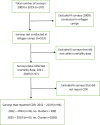Civil war and death in Yemen: Analysis of SMART survey and ACLED data, 2012-2019
- PMID: 36962390
- PMCID: PMC10022117
- DOI: 10.1371/journal.pgph.0000581
Civil war and death in Yemen: Analysis of SMART survey and ACLED data, 2012-2019
Erratum in
-
Correction: Civil war and death in Yemen: Analysis of SMART survey and ACLED data, 2012-2019.PLOS Glob Public Health. 2023 May 3;3(5):e0001915. doi: 10.1371/journal.pgph.0001915. eCollection 2023. PLOS Glob Public Health. 2023. PMID: 37134087 Free PMC article.
Abstract
Conflict in Yemen has displaced millions and destroyed health infrastructure, resulting in the world's largest humanitarian disaster. The objective of this paper is to examine mortality in Yemen to determine whether it has increased significantly since the conflict began in 2015 compared to the preceding period. We analysed 91 household surveys using the Standardized Monitoring and Assessment of Relief and Transitions methodology, covering 2,864 clusters undertaken from 2012-2019, and deaths from Armed Conflict Location & Event Data Project database covering the conflict period 2015-2019. We used a Poisson-Gamma model to estimate pre-conflict (μp, baseline value) and conflict period (μc) mean death rates using household survey data from 2012-2019. To analyse changes in the distribution of deaths and estimate nationwide excess deaths, we applied pre- and post-conflict death rates to total population numbers. Further, we tested for association between excess death and security levels by governorate. The national estimated crude death rate/10,000 in the conflict period was 0.20 (95% CI: 0.17, 0.24), which is meaningfully higher than the estimated baseline rate of 0.19 (95% CI: 0.17, 0.22). Applying the conflict period rate to the Yemeni population, we estimated 168,212 excess deaths that occurred between 2015 and 2019. There was an 17.8% increase in overall deaths above the baseline during the conflict period. A large share (67.2%) of the excess deaths were due to combat-related violence. At the governorate level, posterior crude death rate varied across the country, ranging from 0.03 to 0.63 per 10,000 per day. Hajjah, Ibb, and Al Jawf governorates presented the highest total excess deaths. Insecurity level was not statistically associated with excess deaths. The health situation in Yemen was poor before the crisis in 2015. During the conflict, intentional violence from air and ground strikes were responsible for more deaths than indirect or non-violent causes. The provision of humanitarian aid by foreign agencies may have helped contain increases in indirect deaths from the conflict.
Copyright: © 2022 Guha Sapir et al. This is an open access article distributed under the terms of the Creative Commons Attribution License, which permits unrestricted use, distribution, and reproduction in any medium, provided the original author and source are credited.
Conflict of interest statement
The authors declare no competing interests.
Figures





References
-
- United Nations Office for the Coordination of Humanitarian Affairs. Humanitarian Needs Overview [Internet]. United Nations Office for the Coordination of Humanitarian Affairs; 2018. Available from: https://yemen.un.org/sites/default/files/2019-08/2019_Yemen_HNO_FINAL.pdf.
-
- United States Agency for International Development. Large-scale assistance needs and risk of Famine (IPC Phase 5) likely to persist as wat nears five years [Internet]. Famine Early Warning System Network. 2019. [cited 2021 Jul 2]. Available from: https://fews.net/east-africa/yemen/food-security-outlook/october-2019.
-
- WFP, FAO, UNICEF, FSAC. State of Food Insecurity in Yemen: based on the Emergency Food Security and Nutrition Assessment (EFSNA) [Internet]. 2017. Apr [cited 2020 Jun 27]. Available from: https://reliefweb.int/sites/reliefweb.int/files/resources/wfp291809.pdf.
-
- Robinson K. Yemen’s Tragedy: War, Stalemate, and Suffering. Council On Foreign Relations [Internet]. 2021. [cited 2021 Feb 7]; Available from: https://www.cfr.org/backgrounder/yemen-crisis.
-
- O’Brien S. Under Secretary General for Humanitarian Affairs and Emergency Relief Coordintor, Stephen O’Brien Statement to the Security Council on Yemen. New York; Jan 26, 2017.
LinkOut - more resources
Full Text Sources
